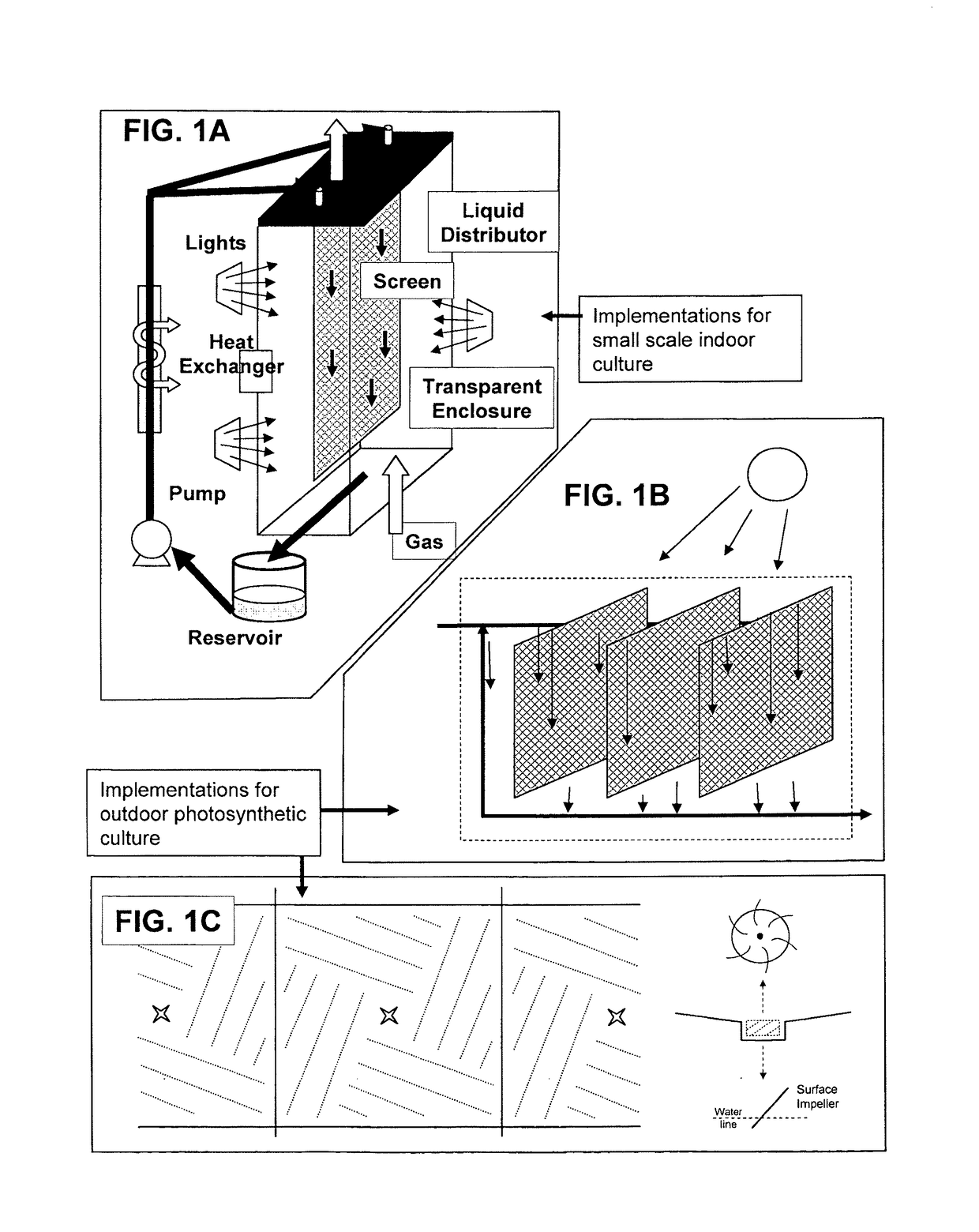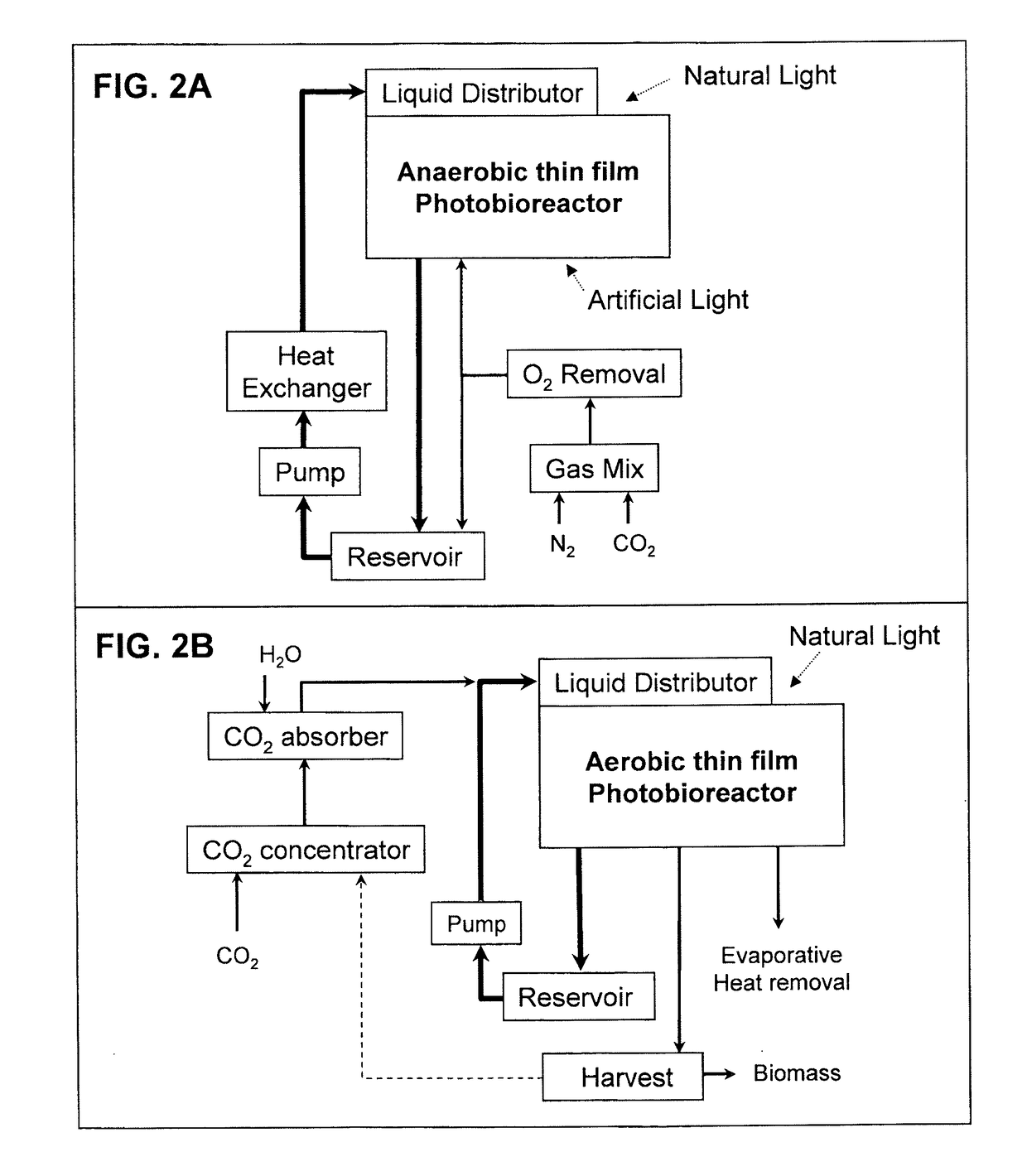Trickle-film bioreactor and methods of use thereof
a bioreactor and film technology, applied in the field oftrickle film photoreactors, can solve the problems that the thin film photoreactors known in the art have not been known for use to culture photoheterotrophs, and achieve the effects of preventing toxicity, good and good, and facilitating turbulent mixing
- Summary
- Abstract
- Description
- Claims
- Application Information
AI Technical Summary
Benefits of technology
Problems solved by technology
Method used
Image
Examples
example 1
[0038]Rhodobacter sphaeroides anaerobic growth and membrane protein production. Rhodobacter sphaeroides (strain ATCC 17023) was grown under anaerobic photo-heterotrophic conditions with fed-batch operation. A formulation for a defined media MR26 (see Appendix A) was provided by personnel at Argonne National Laboratory. Inoculum was grown for a week with 25% media replacement daily in a sealed media bottle to adapt to high light conditions (>500 μE / m2 / s). The shake flask control was half of the 1-L inoculum grown on a NEW BRUNSWICK G10 gyratory shaker (120-rpm, 1″ STROKE). Sampling was conducted 4 times per day including midnight and 8 am to assess biomass loss during the night due to respiration; this high-frequency sampling was assessed with OD660 because it utilized very small culture samples. Using the bioreactor described in detail in the foregoing portions of this patent application, the following growth conditions were observed using the culture thus prepared. Cultures were gr...
example 2
[0047]As a simple demonstration of photosynthetic growth, one of the reportedly fastest growing Cyanobacteria (Synechocccus sp PCC 7002) was obtained and grown on a modified Bold's media formulation. This culture displayed an extended exponential growth with a doubling time of just under 7 hours (FIG. 8B). Since this medium did not support growth to ultra high densities, an extensive evaluation of algae growth media was undertaken to identify a media that would be stoichiometrically balanced. In addition to examining algae media (Bolds, HS) the media formulations for plant tissue culture (MS and B5 media) were also compiled for comparison because these media were developed based on plant biomass elemental composition and have been shown to successfully support high density culture. The resulting medium is given appendix B and is the basis of subsequent high density algal culture work.
example 3
[0048]Growth of Botryococcus braunii in continuous flow trickle film culture for the production of hydrocarbons. Dilute algae cultures will photobleach and die if exposed suddenly to high light conditions. Similarly, the amount of nutrients needed to support ultra-high density algae culture would be toxic if all were added at the beginning of culture. However, if cell density is increased with fed batch culture and then media is removed and replaced at a frequent (even daily) basis, the cells will self-shade and not be exposed to the high concentration nutrients as they are diluted into a culture that is rapidly consuming the inorganics. This operational condition is what would be encountered in an industrial setting. This final example describes the growth of the hydrocarbon-producing strain of Botryococcus braunii strain B that produces C34 isoprene hydrocarbons in an extracellular matrix [Metzger et al., 1985].
[0049]Initial experimentation was carried out to develop the operation...
PUM
| Property | Measurement | Unit |
|---|---|---|
| thickness | aaaaa | aaaaa |
| thickness | aaaaa | aaaaa |
| thickness | aaaaa | aaaaa |
Abstract
Description
Claims
Application Information
 Login to View More
Login to View More - R&D
- Intellectual Property
- Life Sciences
- Materials
- Tech Scout
- Unparalleled Data Quality
- Higher Quality Content
- 60% Fewer Hallucinations
Browse by: Latest US Patents, China's latest patents, Technical Efficacy Thesaurus, Application Domain, Technology Topic, Popular Technical Reports.
© 2025 PatSnap. All rights reserved.Legal|Privacy policy|Modern Slavery Act Transparency Statement|Sitemap|About US| Contact US: help@patsnap.com



